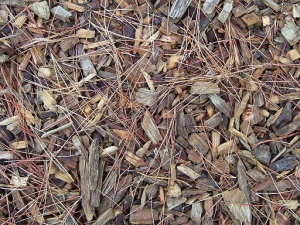Mulch
In addition to its aesthetic qualities, mulch is an essential functional component of many LID practices. Mulch assists in reducing soil erosion, retaining moisture for the plant material, moderating soil temperature, preventing surface sealing and reducing colonization by opportunistic weed species. Wood mulch allows for cation exchange in the upper organic layer of the soil, capturing heavy metals. Regular fresh applications of wood mulch also promotes denitrification, reducing nitrates in impacted surface waters.
Mulch should be applied on the surface of bioretention practices at a minimum depth of 75 mm and added to cover bare
areas in order to avoid erosion. Mulch should only be removed and replaced when
contamination has become a concern, when clogging has occurred, or when surface
storage volume has been reduced.
Avoid the use of stone as a cover for vegetated practices. While stone is a low
maintenance surface treatment, it hinders the addition of plant matter and formation of
topsoil and does not provide the same treatment benefits as mulch. Also,
the stone can be problematic for maintenance if it migrates into the soil.
The use of landscape fabric is a common method of reducing weed species in many
landscapes. However, because landscape fabric is likely to become clogged with
sediment in an LID facility, it is not recommended.
Shredded hardwood mulch is generally recommended for LID facilities. Its fibrous texture knits together somewhat; providing limited erosion control. In areas with particularly high flow (e.g. around inlets) inorganic mulch or coarse decorative aggregate is recommended instead, as these will not float. All organic mulches have the potential to float and migrate in surface flow after a previously dry period. [1]
- ↑ Simcock, R and Dando, J. 2013. Mulch specification for stormwater bioretention devices. Prepared by Landcare Research New Zealand Ltd for Auckland Council. Auckland Council technical report, TR2013/056
